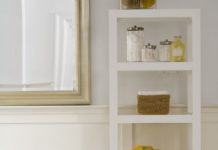
Laminated wood flooring is good looking and hardwearing. But how easy is it to maintain? And what do you do if you find stains on the flooring, particularly ugly rust stains?
First you need to understand what laminated wood flooring is, and how it is manufactured and laid. Then you need to get your head around the best cleaning methods for this type of floor. General maintenance isn’t difficult, but if you don’t get rid of stains as soon as they appear, then you might have problems.
So before we look at how to remove rust stains from laminated wood flooring, here’s the low-down on the generic product and its general maintenance.
Understand What Laminated Wood Flooring Is
In simple terms, laminated wood floors are made from wood by-products that are bonded using pressure. Also known as floating wood tile, laminated wood products are not made of solid wood, but they are made from vinyl either, although most manufacturers also make synthetic flooring, including products like linoleum and vinyl.
Essentially laminate flooring is a photograph of wood grain that is impregnated with melamine (a well known compound commonly used to make synthetic resins and used extensively for kitchen, bedroom and bathroom cupboards), fixed to an HDF (high density fiberboard) core, and then coated with a tough transparent layer that protects it.
Laminate flooring is manufactured in the form of “planks” that you either glue or click together. All should be laid on a suitable underlay.
Maintenance and General Cleaning Tips for Laminated Wood Flooring
One of the most common problems when it comes to laminate flooring is that the specialist products manufactured and used to clean it often have a tendency to build up on the surface. Another gripe is that cleaning products create a slightly sticky film on the surface, though diluting the cleaner with water sometimes solves the problem. Steam mops tend to create a streaky mess, and even using plain water tends to leave streaks as the water dries on the surface.
Some people find that a mix of vinegar and water (50-50) works well, though you need to use an effective mop or steamer that prevents the solution from drying on the floor. Others find that a few drops of dish detergent or washing up liquid in warm water works well (use one that has lemon added to it).
But perhaps the most popular solution is to use a window-cleaning product. Sweep or vacuum any dust or loose dirt; spray the cleaner on your floor in sections; mop using a device that has a flexible head and thick removable micro-fiber pad.
Getting Rid of Rust Stains that Threaten to Mar the Good Looks of Your Floor
Even if you are fanatical about keeping your laminated wood flooring clean, rust stains can be a real problem. Often caused by leaving something metal on your floor, that rusts when it comes into contact with water, the stain is made up of tiny little particles of iron oxide. The problem is that some chemicals or substances can make a rust stain worse. A chlorine-based bleach, for example, will react with the rust and might intensify the effect of the discoloration on your floor, or cause it to bleach or yellow.
Often people recommend nail varnish remover to get rid of this type of stain. While it will get rid of the rust, it is also likely to lift the laminate.
Another product that people sometimes suggest is oxalic acid, a white powder found in hardware stores. Like hydrogen peroxide, oxalic acid is a type of bleach, and as such it is a strong chemical. While you may be successful in getting rid of the rust stain with oxalic acid, the danger is that it may bleach the surrounding area as well.
So what works without compromising the flooring itself?
Commercial Rust Removal Products
There are various commercial rust removal products on the market, some of which work better than others. See if you can get feedback from other consumers who have tried the products available in your part of the world, specifically on laminated wood floors, and follow the manufacturer’s instructions. Also check the label to make sure that there is no warning in terms of possible damage as a result of usage. This might be in tiny print that you don’t even notice.
The safest types of commercial product are those that are water-based – where you use water to clean up rather than another type of solvent. Ultra On Rust Remover is one such product that is also biodegradable and non-toxic. Others include:
- Bar Keepers Friend Lime & Rust Remover – which some people swear by and others insist doesn’t work – that you make into a paste and paint onto the stain and wipe off; because you don’t scrub it, it shouldn’t damage the laminate.
- Zud Heavy Duty Cleanser that is manufactured to remove rust and other “tough” stains.
- Whink Rust & Iron Stain Remover that is recommended for vinyl finishes and so should be perfectly safe when used on laminate flooring.
Even with recommendations, before you start your cleanup, test a small section of the stain with the product you have chosen, to make sure it doesn’t have a damaging effect.
Homemade Concoctions that Get Rid of Rust
If you want to avoid chemicals (and save money at the same time), try some of the “tried and tested” home remedies other people use to get rid of rust. But always do small section test before you attack the whole stain.
Vinegar is a great cleanser, and it can be mixed with various other ingredients to make successful stain removers. One home recipe involves mixing vinegar (use a white spirit vinegar, not a brown malt vinegar) with equal parts of bicarbonate of soda and water to make a thick solution. If you want to make a paste, add more bicarb. Paint on, and leave until it takes effect. Rinse with clean cold water and wipe dry.
Another remedy that can work really well, depending on the intensity of the rust stain, is to sprinkle the stain with ordinary fine-grain table salt. Then slice a lime or lemon in half and gently rub over the salt. Don’t use coarse salt because this might scratch the surface. If this doesn’t work sprinkle more salt onto the stain and then wet the area with lemon juice. Allow the lemon and salt to soak into the stain overnight (for about 24 hours). Rub gently with half a lemon and then rinse with water.
Liquid ammonia is another solution that some people choose to use, and it can work. But because it is poisonous, only use it as a last resort. Add two tablespoons of ammonia to four cups of warm water and pour over the stain. Blot with a cloth or paper towel and then rinse with cold water. Wear gloves and don’t inhale the gases it gives off. Ideally wear a mask as well.
If you do decide to try oxalic acid, dilute the powder with double the quantity of warm water (1:2), and rinse thoroughly with fresh water once it has taken effect (it can take up to an hour). Wear gloves and avoid inhaling the fumes.
Whichever rust stain removal solution you decide to try, always wipe the excess rust off the surface with a damp cloth before you start. And always do the “small section test”.







































